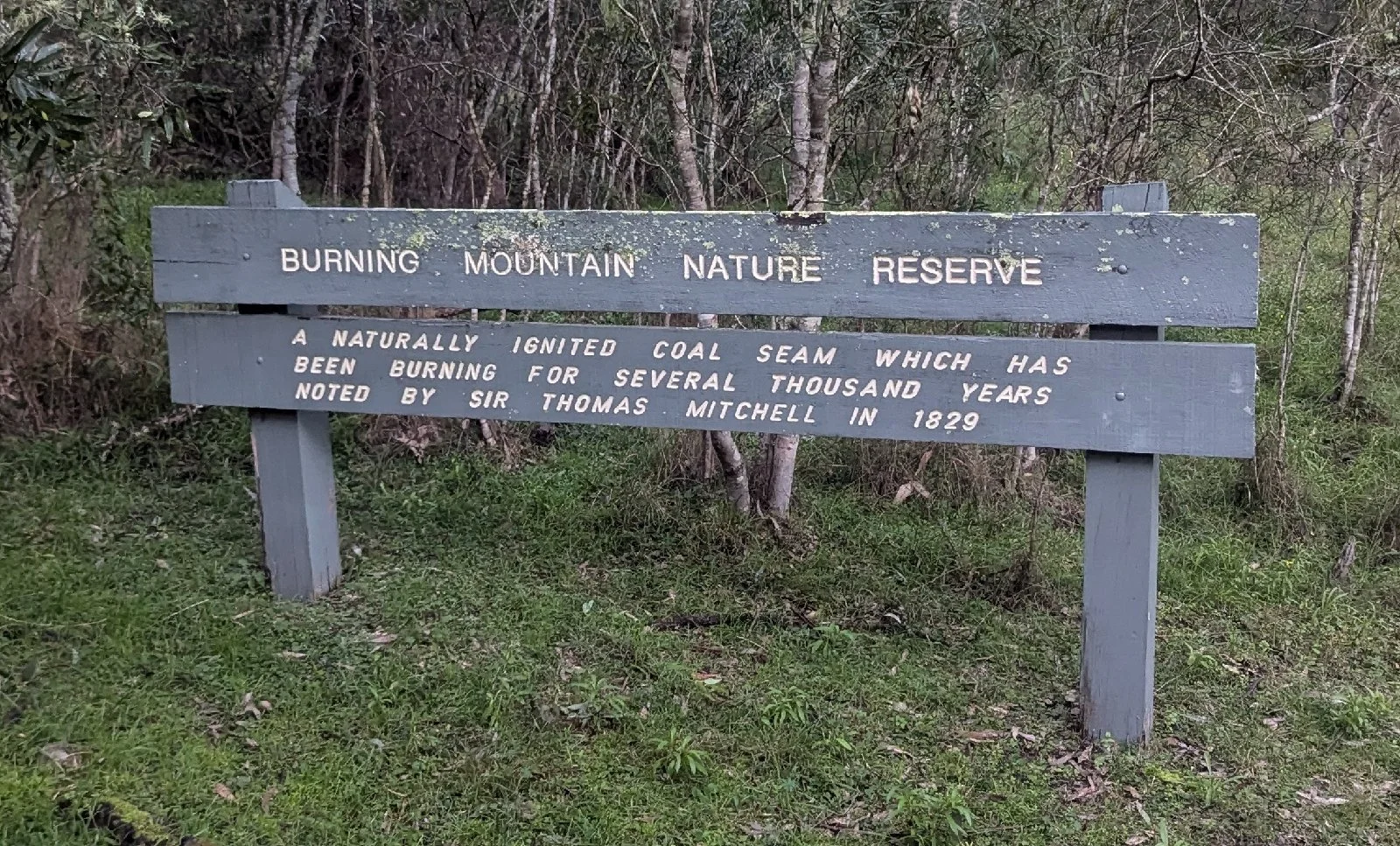Not As It Seams: The everlasting smoulder of Mt Wingen, Australia
I would like to thank the Wonnarua people, the original guardians of Mt Wingen, for passage to the hilltop, and for sharing the stories of their country’s creation with me.
224 km north of Warrane, just off the New England Highway, lies the small town of Wingen. Nestled amongst the grapevines of the Upper Hunter region, with a population of just over 300, Wingen (win-jen) holds a burning secret. A 6000 year old coal seam fire smoulders beneath 30m of sandstone, gobbling the landscape. On its journey so far, it has torn through 6.5 km of bushland, and now continues over Mt Wingen.
Mt Wingen is in the country of the Wonnarua people, with both the town and mountain taking its name from the local language, meaning "fire". Wonnarua stories tell us of how war broke out with a neighbouring country, leading to the death of a Wonnarua man. Upon the men’s return from war, the wife of the man killed could not find him. Frightened, she raced up the nearby mountain to search for him. After she could still not see him, and realising that he had been killed, she begged Baayami to end her life. The great sky father could not kill her, and so he transformed her into stone where she sat, crying tears of flame that cascaded down the mountainside, setting the nearby hill alight. You can still see her grieving upon the mountain today, now known as Wingen Maid.
The first Europeans to find the fire in 1828 thought it was an active volcano. It wasn't until a year later that geologist Rev. Wilton identified the smoke as coming from an underground coal seam. Over the years, research asserts that the fire was ignited around 6000 years ago, near the Pages River, probably due to spontaneous combustion, or even a lightning strike. It now crawls southward at just over a metre per year. Cracks through the sandstone allow ventilation, with air rushing in and feeding the fire, bringing the underground temperature to 1700°C.
Burning Mountain, Mt Wingen
Having moved to the New England region 4 years ago, I had not heard about it until my mother-in-law recounted her school excursion there as a teen. A quick Google search confirmed it to be only a two and a half hour drive from my home in Armidale. My husband, housemate, and I piled into the car on a wintery Sunday afternoon and rolled our way past Tamworth in search of this everlasting smoulder.
With our arrival at the hidden, run down rest area, we felt quite underwhelmed. Faded signage, litter, run down facilities, and the onset of heavy rainfall almost made us turn around for an early dinner at Guzman y Gomez. However, as the rain dissipated, we felt our conviction blossom, and thus we emerged from undercover and began our trek. The path wound us along a ridgeline spotted with eastern grey kangaroos, accompanied by their bright-eyed joeys, and red-necked wallabies, a tad more skittish. Thorny bushes pricked our skin and snagged at our clothes, which we later discovered was Acacia paradoxa, more commonly known as kangaroo thorn. With beautiful blooms in Spring, we plan to return for a day dedicated to art to capture its beauty.
Effects of the smoulder, Mt Wingen
As the path wound around the mountain, we entered a hellish, almost foreign landscape. Tall, bare ironbarks and stringybarks stood amongst an area free of scrub or underbrush. My first reaction was that a bushfire had ripped through the valley, leaving a path of grey, though a few growths of Coastal Tea Tree (gaudium laevigatum) had sprouted and thrown roots down.
Emerging after our uphill trek, we came upon an open scene with a picnic table, but no fire-ravaged landscape. As disappointment swept through me, I began to suggest we had taken a wrong turn. It was at this moment that our housemate blurted, “I see smoke!!” and pointed into the bushland. We raced our way into the darkness, only to find ourselves upon alien terrain.
Before us, a gash of red and white marked the greenery, with multiple smoky plumes falling into the sunset. The sulphur rich stench burnt my sinuses, though the swirls and chirps of a Willie-Wagtail alleviated the headache. We could feel the heat from the earth, the warmth pushing against the cracked skin.
As we descended back into the valley, our phones acting as our only light source, I couldn't help but feel the immense awe and overwhelming love for the Great Escarpment and its pockets of beauty all around me. I feel such anticipation of the treasures I have yet to find.
Plumes of smoke, site of the underground coal seam fire, Mt Wingen
"Burning Mountain Nature Reserve". Department of Environment, Climate Change & Water. Retrieved 8 July 2025. https://www.nationalparks.nsw.gov.au/visit-a-park/parks/burning-mountain-nature-reserve
“Burning Mountain”. Wikipedia. Retrieved 8 July 2025. https://en.wikipedia.org/wiki/Burning_Mountain.


